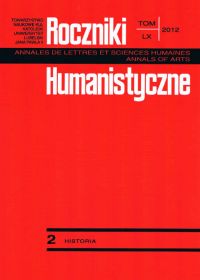Peace order in Central Europe after the World War II, as perceived by the Polish Revival Front
Abstract
The Polish Revival Front construed its conception of the peace order on the grounds of universalism and the moral principles approved by the Catholic Church. In order to ensure future prosperity of Central Europe, Poland would initiate an empire (a bloc of Baltic and Balkan states), which would rely on the Polish tradition of peaceful unionism, Catholic morality and culture.
In the east, Poland would have its border as proclaimed by the Treaty of Riga before the war. In the west, Germany would resign the land of the Oder estuary – with the isles of Rugia, Uznam and Wolin, along with the lands west of the Oder and Neiss, as well as East Prussia and Gdańsk. The German lands stretching between the Elbe, the Baltic, the Czech Republic and the western borderland of Poland would stay under long-term Polish, Czech and British occupation – supervised by Polish authorities, though. The objective of this occupation action would be to deprive Germany of the West Slavic territories stretching up to the Elbe, through the incorporation of the Lubus land, granting autonomy or creating a protectorate of Lower and Upper Lusatia within the structure of the Polish state; and concluding federations with the lands of Brandenburg and Mecklenburg. Germany would thus be isolated from the Baltic (optimally, by a Danish-Polish border) in the north, while in the south, they would have no access to the Danube region. Finally, the Kiel Canal would stay under international control. In order to prevent Soviet imperialism in the Balkans, Poland and Romania would wield control over Moldova, while Finland and Estonia would cooperate to isolate the USSR from the Baltic.
References
Bender R., Zofia Kossak-Szczucka, Encyklopedia Białych Plam, t.X, Radom: Polskie Wydawnictwo Encyklopedyczne 2003.
Eberhardt P., Polska i jej granice. Z historii polskiej geografii politycznej. Lublin: Wydawnictwo Uniwersytetu Marii Curie-Skłodowskiej 2004.
Korboński S., Polskie Państwo Podziemne. Przewodnik po podziemiu z lat 1939-1945, Warszawa: Świat Książki Bertelsmann Media 2008.
Kunert A. K., Ilustrowany przewodnik po Polsce podziemnej 1939-1945, Warszawa: Wydawnictwo Naukowe PWN 1996.
Muszyński W. J., W walce o Wielką Polskę. Propaganda polityczna zaplecza politycznego Narodowych Sił Zbrojnych (1939-1945), Biała Podlaska: Rekonkwista−Pruszków: Rachocki i S-ka 2000.
Ponczek P., Idea federacji europejskiej w polskiej myśli politycznej (1939-1945), w: Proces integracji Polski z Unią Europejską, red. P.Dobrowolski, M. Stolarczyk, Katowice: Wydawnictwo Uniwersytetu Śląskiego 2001.
Ponczek E.: Polska myśl o pokoju w latach drugiej wojny światowej (1939-1945), Łódź: Wydawnictwo Uniwersytetu Łódzkiego 1999.
Przybysz K., Partie polityczne Polski podziemnej 1939-1945, Warszawa: Oficyna Wydawnicza ASPRA-JR 2006.
Przybysz K., Wizje Polski. Programy polityczne lat wojny i okupacji 1939-1944, Warszawa: „Elipsa” 1992.
Strzembosz T., Rzeczpospolita podziemna. Społeczeństwo polskie a państwo podziemne 1939-1945, Warszawa: Wydawnictwo Krupski i S-ka 2000.
Copyright (c) 2012 Roczniki Humanistyczne

This work is licensed under a Creative Commons Attribution-NonCommercial-NoDerivatives 4.0 International License.





